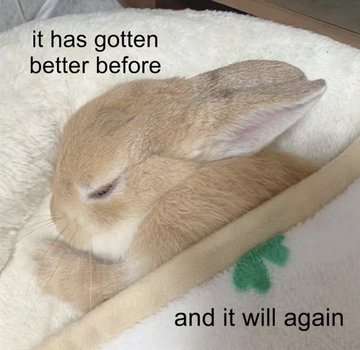so yea ... planning to do that now... but how does it work? what even is meditating? how long to do it? (or be it? and what is it? 🤔) and when they say needs to be daily do they like literally mean daily?
also anyone got the full episode of this one? 🥺 (love the guy, but cannot afford patreon right now)
thanks, love you all 🥰
There are a lot of different ways but one very basic method is simply to think of: nothing. This is much harder than it sounds (or maybe it does sound hard). But basically it's very easy for your mind to just go off on some random train of thought without even realizing. This form of meditation conceives your mind as a train station with trains pulling in & out. Most of the time we don't even think about what train we board and we're halfway across the country before we realize we even boarded it. This meditation tries to teach you to recognize you're about to board the train so you can decide whether you want to board it.
In practice it is too hard off the bat to think of literally nothing so this is why people focus on their breath.
A good amount of time to meditate to start is 10-15 minutes. Ideally you would do it every day but it is difficult to be consistent. Like surprisingly difficult to take 15 minutes out of your day to do literally nothing. Something in the mind resists it (probably the bad part).
so meditating was something i wasnt all too serious with, but it helped give me a good habit with my thoughts.
you are teaching yourself not to fixate on thoughts that come into your head. This is a source of a lot of stress in your life cause you can find yourself tied up thinking about things that are wasting mental processes. Things will pop into your head that only need your attention for that moment. So it's a bit of a discipline, to actively meditate is to keep your mind in that state where it isn't fixated on something. It's a bit like when you float in water. Your attention still drifts, but it doesnt lock into anything. You notice small things, like the feeling of your clothes if this is something you normally block out, small sounds of your environment. It's a way to reduce internal distractions in your head. In many practices you are taught to listen to the sounds of your environment, the idea is to reinforce not getting caught up in what errant thoughts come into your head. It's also important for the practice not to make it being all "head empty no thoughts" since it's really not that possible. It's about THE WAY TO head empty no thoughts as it seems like it's understood how difficult it is to keep your mind clear.
 <- This is what we aspire to.
<- This is what we aspire to.It’s been a while since I’ve used it but I used to use the app Headspace which had some nice guided meditations, the paid version is way too expensive but the free ones kinda taught me what to do and how I just do it myself when I feel the need
The most helpful kind for me, and what I now do myself, is a body scan thing. So I close my eyes and just focus on each part of my body starting with the top of my head and going down to my toes. How does my scalp feel? My face muscles? My neck? Shoulders? Etc.
theres basically no wrong way to do it, what worked for me personally for my goals was using the Corpse Pose from yoga on a hardwood floor. it can take a few minutes to 'finalize' your position, make sure you are truly comfortable enough to remain motionless. then i would focus on simply perceiving my surroundings, all of the sensory input coming into my mind, constructing a kind of mental map of the surrounding world. i've done it with eyes open and closed, with eyes open i get a kind of pulsating television static overlay on my vision and a weird mental state good for existential pondering, with eyes closed i can let my eyes do what they want as they for some reason tend to kind of 'roll back into my head' (point upwards to the edge of my eye socket and kind of twitch), which for me can produce either generic pulsating blob phsophene-like visuals, or in rare cases detailed pseudo-hallucinatory experiences (visuals in the 'minds eye', not in actual sight)
Take a yoga class (ideally a breathing-focused one) or just attend Catholic mass for a few years. It was yoga that really taught me. The guided meditation makes you better at regular meditation.
It seems like lots of people have their own approaches and ideas. The way I do it, and I don't do it nearly often enough, is like this:
I close my eyes, and begin to take in a slow, full, deep breath.
As I inhale I think about everything in my mind, consciously tagging every worry and idea floating around my head. I stimulate them into noise
By the time my lungs are full, my mind is a cacophony. I linger before i exhale, savoring this moment of anticipated release, a brain full of sound and thought, all of it about to die a temporary death. It's like being on the top of a roller coaster.
Finally I exhale, and it's like pulling the plug of a bath or blowing out smoke. Everything held in my head (or just some of it, and thats okay too) flows out of me and is carried away on the wind. For one sublime moment, nothingness reigns. New thoughts crop up almost immediately of course, it's like digging a hole in sand; it fills in quickly, but you get momentary glimpses of what lies beneath.
Then I start inhaling again, stoking my worries to louder and louder self-expression to heighten the pleasure of their purging.
I'm audhd, and when I get super focused in on something for many hours until my head feels too heavy, this helps lighten it up again.
After some predetermined number of breaths (I hate the idea of trying to meditate with a ticking time waiting to removedme) I open my eyes feeling renewed
There have already been good answers here. I thought I'd add my two cents, and also comment on the advice of "don't think".
There are many types of meditation, I would say pick one for now and try it daily. Even if it is just 5 minutes or less. Better any meditation daily than none. It's like practicing an instrument, it's better to pick it up and play just a little each day than to "save up" all your practicing on the weekend. Meditation is about building new habits, so it must be reinforced daily. Also, it is going to be challenging. So if you want to try different techniques there may be a danger to "shop" around different styles whenever you encounter the inevitable difficulties. On the flip side, it's fine to try different techniques. A good balance may be to pick a single technique at the beginning of the meditation session and stick with it during that session.
For a beginner, you can do meditation for 5 to ten minutes. Later you can extend it to 30 or more. If you don't have 5 minutes, do it for any time then. Do it during little moments you find throughout the day. Better some than none.
One of the most commonly described meditations is anapanasati - meditation on the breath. There are other meditations where you don't focus on anything - shikantaza in Soto Zen for example. I won't discuss shikantaza, though. I've heard one Zen teacher group meditations into either directed attention (anapanasati, etc.) or undirected attention (shikantaza). Even if it is too simple of a classification, it does show that there are different styles.
Most people start with anapanasati, focusing on the breath. The goal is to be mindful of your breathing and to "flex your muscles" of concentration. Sit in a posture, you can be sitting in a chair or sitting lotus, half-lotus, doesn't matter. Make sure your back is straight and shoulders aligned, like a string is pulling you up from your head.
Now take a breath. Breathe in and out. Try to feel the sensations of that breath. Do you feel a tingling as air passes through your nostrils? Do you feel your abdomen expand and contract? Maybe you feel it in your back? Most recommend focusing on the sensations of the nostril, but focus on what part of the physical sensation of breathing you find easiest and stick with that. If you feel neither then take larger breaths until you feel them and then return to your normal breath. If you feel nothing, then your meditation practice for now will be to keep breathing and build up a noticing of the sensations - but it shouldn't be too hard. Some people like to visualize the breath, but I've been told not to. You can try it though if the above is not clicking with you.
Once you can feel the sensation of your breath (I feel it in my nostrils as I breath in and out) then the goal now is to breath as normal and to center your attention of that area (i.e. the nostrils). You can also count your breaths. As you breathe in and breathe out that's "one", etc. up to ten. And start over.
Now what's going to happen is that you WILL think! A thought will come up, it is very natural. This is where I will push back against others who said "don't think".
Thoughts are going to pop up, it's normal and if you try too hard to force yourself to not think then you are going to set unrealistic expectations on yourself and get discouraged. It's like pulling on a rose bud to get it to bloom faster. So first, you must not judge yourself for thinking. Don't force yourself to not think either, as you'll just get into some meta-type of "thinking about thinking".
Thoughts will arise like random noise and we shouldn't judge ourselves for it, but we don't have to follow our thoughts. We don't have to indulge in them and let them take us for a ride. This happens all the time and we don't even realize it 99.99-whatever% of the time.
So we can't stop thinking (for now) but we can focus on our object of meditation - our breath. Keep breathing and counting. Likely what will happen is that you will notice that for the past couple of breaths you have been forgetting to count, you haven't noticed the physical feelings of the breath, and you've been daydreaming or following some random chain of thoughts. "Uh oh" you may think - well, that's expected. No judgement. This is a new practice for you. If you notice this has happened then it's good, actually! You noticed you were lost in thought for a moment. Good! Keep noticing it when it happens and return to your breath. Feel the breath again and start back at one.
This is going to happen over and over. Deciding to focus on the breath, focusing, losing focus, getting lost in thought, noticing, returning to the breath.
It's very important for you to see the above as normal and actually good if you are a beginner. The goal isn't to get to 10 counted breaths for now. The goal is to "catch" yourself getting lost in your chain of thoughts, giving yourself a little pat on the back, not making much of a fuss one way or the other, and then getting back to your breath. Don't think of "10 breaths" as a goal. Ten is arbitrary. It's better to only get 3 very focused breaths for 10 seconds before losing attention and noticing than to subconsciously count ten breaths and you haven't noticed your mind has actually been all over the place for the last two minutes singing theme songs and replaying conversations for the past minute. In some ways, the more you "fail" at meditation the better. It means you get more practice in noticing your wandering mind. This also builds concentration, which is good for other forms of meditation.
The goal isn't to stop the thoughts, the goal is to not "hop on board" with them and let them take you to who knows where. The way to build this strength is to focus attention on your breath. When thoughts come up let them naturally pass like a cloud. Something you'll notice is that if you don't feed a thought, it does sorta just go away on its own. Our mind so badly wants to cling to thoughts and let them take us on their trip, but the thought alone actually is very ephemeral and comes and goes pretty easily. Through practice you can start to notice things. You can start to feel less identified with these thoughts that pop up and want to take you away.
Though, trauma may cause powerful thoughts may keep coming up. I'm not trained to give advice with that. And I apologize, I should have said that earlier. If a thought keeps coming up then it's probably your mind trying to tell you something very important. But I don't have enough experience to give good advice for something in this context. Also, meditation practice is powerful and can lead you to dark places if you aren't careful. Some silicon valley types who meditate for "productivity" have found that out. Also, you must always pair meditation with an ethical practice.
As you practice breath meditation and get better. You can try other techniques like labeling. This is where you give a simple label of classification to the thoughts or sensations you feel.
You can also try other objects of meditation instead of the breath. You can even try meditation without any object. Letting thoughts come and pass by without letting the take you along for a ride. Just keep returning to your posture as you do this.
thank you for your and everyones reply, really appreciate it! 🥰
i tried different meditating things over the last few days and really seem to struggle with the "focus on the breathing" aspect of it. if i focus too much (which is not a lot) i start to feel uncomfortable and eventually forget how to breathe, which leads to the sensation of not getting enough oxygen. even after stopping, it takes me like 10 minutes to not think about breathing anymore to be able to breathe normally again.
anyway, i got some of those baoding balls, which are super nice. i can better focus on the breathing somehow, as i get a bit distracted from it. but even with them, i cannot really sit quiet more than 5 minutes, because of all the thinking and impatience.
Thoughts will arise like random noise and we shouldn’t judge ourselves for it, but we don’t have to follow our thoughts. We don’t have to indulge in them and let them take us for a ride. This happens all the time and we don’t even realize it 99.99-whatever% of the time.
i get all kinds of random anxiety inducing thoughts throughout the day. they can circle or focus about hurtful things or seemingly (very mild, so not really; no trauma whatsoever, worst that can happen is a panic attack) existential threats, but are mostly about random stupid shit. just by being aware of those thoughts, as in oh look, thought A is coming, it will probably lead to emotions X and Y, should i ride along with it right now? i am able to stop ~80% of the shit that i could never stop before. kinda crazy!
also interesting is, that i can break actual hurtful/threatening thought spirals, but not random thoughts that have zero impact on my life. *like whats up with that elizondo guy, does the cia want me to believe aliens are real now? and do people really watch this hasan guy? *its weird how much those 2 questions alone will enter my mind again and again and again and again and refuse like crazy to leave, while i can somehow – with a simple 2-second choice – just not engage with personally deeply depressing or real-life actual frightening things.
crazy stuff. super glad, i finally got into it.
ps. what do you mean with
Also, meditation practice is powerful and can lead you to dark places if you aren’t careful. Some silicon valley types who meditate for “productivity” have found that out. Also, you must always pair meditation with an ethical practice.
for my ethical practice idk, i was really "anti everything spiritual" the last 15 or so years. But my best friend got into all that, and then when I listened to this episode of refleft, it set off the whole thought process (and the one linked in the post made me decide to really start it). but yea, new to all of it.
Hey sorry for the late reply, I hope everything is still going well. I’m happy to hear that there is some benefit you’ve seen with meditation already. Meditation is a lifelong journey (if you’ll forgive my corniness lol) and it can also come in phases. In my life so far, I’ve had periods where I stop meditation completely and then come back to it when I feel like I need it. It would be better to be consistent and as one’s discipline grows it can/should be. But I’ve heard that for many people they have these “waves” in their life. Breht actually discusses it in the revleft episode you mentioned! That was actually originally posted on the Red Menace podcast with Alyson. They actually have a part II of their discussion: On Mysticism II: Enlightenment, Non-Duality, & Perennialism and I wanted to let you know of it. It’s an interesting episode as it talks about mysticism from a Buddhist (Breht) and Abrahamic (Alyson) perspective.
In fact revleft has a lot of episodes about meditation and mystical traditions across various religions. I’ll spam you with a few:
Buddhist Philosophy: The Four Noble Truths and The Eightfold Path
Buddhist Enlightenment: Impermanence, No Self, and the Dark Night of the Soul
Awakening from the Dream of Separateness
Meditation, Materialism, and Marxism
On Meditation (Patreon Teaser)
[UNLOCKED] Buddhist Perspectives: Self-Immolation and Political Struggle
Is Marxism just Religion by Another Name?
Religion and Marxism: Thinking Through the Human Condition
Approaching Organizing and Spirituality w/ Rev Left Radio
Contemplative Practice and Political Struggle
St. Francis of Assisi: Patron Saint of Ecology & Brother to All Creation
Early Christianity: Psychedelics, Ancient Greece, and the Emerging Church
Sufism: Islamic Mysticism and the Annihilation of Self in God
I know what you mean by being ‘anti everything spiritual’. I was definitely like that, but I was still in to philosophy as I have wanted to seek solutions to the emotional problems I feel I’ve had my whole life. I found Buddhsim, but my anti-spirituality forced me to adopt a secular Buddhism. Then later I was interested in Lacan, existentialism, etc.. I then came back to Buddhism on a more spiritual level through realizing that there’s a lot of overlap between Buddhism and the concepts in Lacan (and other psychoanalysts) of ‘lack’, ‘The Real’, etc. It wouldn’t do any good to explain it, but I found a way to ‘make sense’ of the mysticism in a way that wasn’t too antithetical to my materialist worldview. In fact, I’d also argue that there is a lot in common between the metaphysics of Buddhism (or other traditions like Daosim) and Dialectical Materialism.
What really set this off for me was reading about the similarities between Tiantai Buddhism and Zizek’s psychoanalytic philosophy despite the latter’s criticism of Buddhsim Is Žižek a Mahāyāna Buddhist? śūnyatā and li v Žižek's materialism. The text was my introduction to Tiantai Buddhism, which actually opened me up to mystical ideas in a context I was already comfortable with. Unfortunately, Zizek is very much a western chauvinist and has become more and more cringe over the years.
Regarding my comment about meditation taking you to dark places if one’s not careful, Breht actually talks about that in the above episode I linked. Essentially, though, meditation is part of a mystic or, if you can stomach the word, sprititual practice. Certain spiritual truths may emerge when doing meditation. And if you don’t have the context or community to help you may find that mediation can worsen some existential crises or reintroduce trauma that you have suppressed. Imagine your mind as a pool of rough and murky water. Meditation helps still the waves so the murk can settle. When that happens you can see much further into the pool, but you may see things you aren’t ready for. That probably sounds cliche, but I think there is some truth to it. And Breh talks about how people who have been thrusted into intense meditation retreats can have trauma from it. If you are just meditating for 5 to 30 minutes a day, though, I don’t think you have to worry about psychotic breaks or anything. But, I wanted to mention this because meditation is part of a spiritual practice. Eventually, some truths will come out of it.
Another reason that it can be dangerous is that there are “gurus” and teachers who have done a lot of meditation. They probably have seen or felt certain truths on life, but they still end up acting unethically. They abuse their position and act ego-ically. Their meditation can give them greater control of some parts of their ‘selves’, but without an ethical practice they abuse what they’ve gained. Once again, meditation is just one part of a spiritual practice. Ethics must be part of it too. Some will say that by doing meditation ethical practice naturally follows, others disagree.
I hope you continue to do well, and best of luck!!
thank you so much. i will look at everything and continue. really apreciate it and wish you all the best too! ❤️❤️❤️







